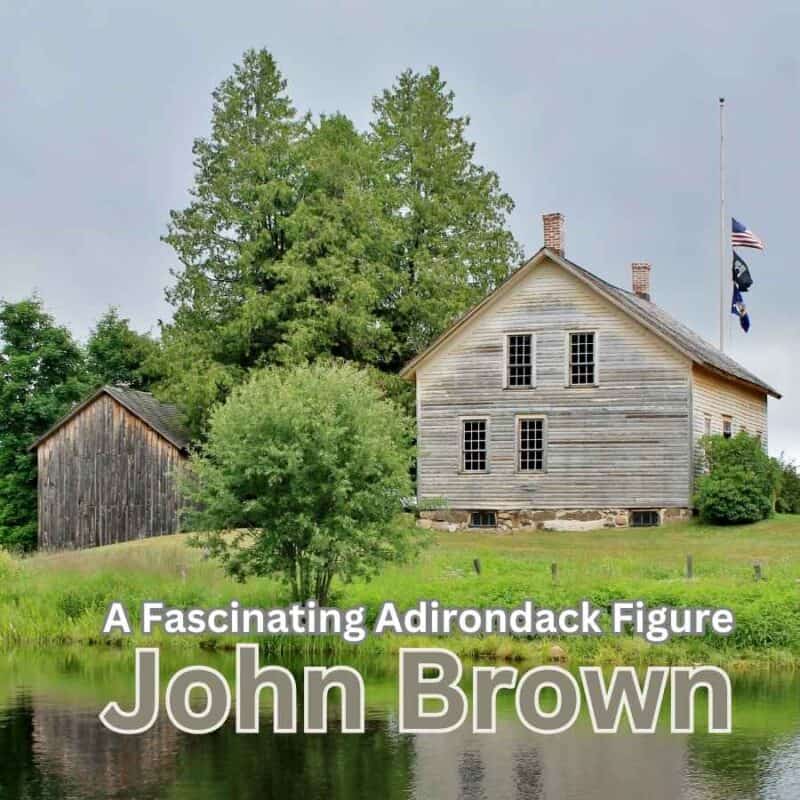A Fascinating Adirondack Figure: John Brown
Let’s take a tour of abolitionist, John Brown’s Farm in Lake Placid (NY). My sweet husband and I visited the farm last week-end on our little get-away to the Adirondacks.


John Brown was a quirky character, a radical abolitionist who farmed in the Adirondacks, called Frederick Douglas and other well-known abolitionists “friend,” and fought in the “Bleeding Kansas” conflicts, to ensure that Kansas would become a free (rather than slave) state.

You may be familiar with the words of the folk song, “Old John Brown lies a-moldering in his grave.” Well, he was in fact buried on this site in Lake Placid on December 8, 1859, having been hanged for treason in Harper’s Ferry, West Virginia on December 2nd.

But prior to the events that transpired in Harper’s Ferry, John and his second wife, Anna, called this small cottage in the mountains home. They farmed the land and gave help and advice to their black neighbors in and around Essex and Franklin counties in Northern New York.

I’m not sure how they fit sixteen people into this small space, but to a farmhouse lover, the interior is simply charming.

I learned after taking a few shots that photographs were not allowed (oops!).

The day we stopped by, they had just opened a permanent exhibit–Timbuctoo–commemorating land grants of 120,000 Adirondack acres made in the mid-1800’s to hundreds of African Americans by abolitionist Gerrit Smith.
These 40 acre grants gave opportunities to families to start a new life, but perhaps more importantly, gave them the right to vote. At the time of the grants, black men had the right to vote, but only if they owned $250.00 worth of property.

While the John Brown farm looks lush and fertile, most of the land in the Adirondacks is quite rocky, and the black farmers, many of whom had never farmed before, found life their difficult.
Despite the questionable success of Smith’s land grants, it did capture the imagination of many abolitionists, made headlines in newspapers, and helped galvanize participation in the abolitionist cause.

John Brown, an able farmer who fathered twenty children and generously gave aid to his African American neighbors, carried a burning rage against slavery.
After participating in something like guerilla warfare in Kansas, he made plans and raised funds from well-known abolitionists to encourage a black insurrection in the south. He chose an armory in Harper’s Ferry, VA (now WV) for his opening salvo.
Believing that God was leading him, he and a small band of men, including three of his sons, captured the armory, but killed seven men in the process. And just one day later, Col. Robert E. Lee liberated the site.
Brown’s ultimate goal of freeing southern slaves and founding a new state for freed slaves failed completely.

The famous abolitionist and newspaper publisher, William Lloyd Garrison called him, “well-intended, but sadly misguided.” But Ralph Waldo Emerson predicted that “[John Brown] will make the gallows glorious like the cross.”

Love him or hate him, the life of John Brown certainly merits consideration, particularly given the horrific events in our own recent history, e.g., sex trafficking.

I have just one final thought on the man. Many historians believe his failed take over of the Harper’s Ferry armory hastened the start of the Civil War, which of course resulted in the end of slavery.
Where do I fall on all of this?
I’m a violence hater, but I can understand why someone might feel violence necessary to stop slavery. When I think about the human trafficking going on in the world today, I feel some burning rage. Don’t you? Surely the silver lining of Harper’s Ferry debacle was its hastening of the Civil War.

I had not planned to get quite so deep in this post, but for all of you who stuck with me, I hope you found this look at John Brown and his bucolic farm interesting, if not thought-provoking.
Here are two organizations dedicated to ending human trafficking:
A21 Campaign/Abolishing Injustice in the 21st Century
Project Rescue
Other posts you might enjoy:
Lindenwald (Home of President Van Buren)
Johnson Hall (Home of Sir William Johnson)
Thanks for stopping by–
If you enjoyed this post, subscribe today
and get a FREE copy of my eBook:
Bye for now,


I’d love it if you’d pin for later!






A very thoughtful post. I had never heard of the Timbucktoo land grants before. We U.S. citizens do need to reflect on our national history.
Thanks for reading the post; we certainly do have much to think about and consider–
Very interesting. I suspect I learned this in school but it was so long ago… I am glad they let you keep your camera 😊
Me too, Debra 🙂 They were quite nice about it actually.
Nice post. A bit of a change of pace for your blog. I spent a summer in New York when I was in college and visited the John Brown farm. It looks as lovely as I remembered it. By the way, you have the burial year as 1959 in your post. Might want to fix that.
Yes, Eddie, I like to mix things up every now and again. I’m a history lover at heart. So neat that you’ve been to the site before! (Thanks so much for alerting me to the typo.)
Interesting bit of history.
Agreed 🙂
Not only do I find this biographical post fascinating, but I am one who celebrates John Brown’s importance, not only in our United States’ history, but in my own state’s history. As you probably know, we did become a state separate from VA in 1863, perhaps at the provoking of John Brown’s earlier attempts in 1859. But brother fighting against brother was not uncommon in our state, struggling with the issue of personal freedom and siding with North vs. South. THank you for sharing this quaint homestead, Diana. I love the history.
I had no idea the history of WV becoming a state. I just did a little googling on it and it truly is fascinating, Rita! I’m wondering if the Harper’s Ferry armory is some kind of museum now? So glad you enjoyed the post 🙂
A couple of quotes come to mind…when speaking of John Brown, “”All tyranny needs to gain a foothold is for people of good conscience to remain silent.” from Thomas Jefferson.
Paraphrased from those before him, Winston Churchill said, “”Those that fail to learn from history, are doomed to repeat it.”
Abraham Lincoln closest in context to John Brown’s actions wrote, “”Human nature will not change. In any future great national trial, compared with the men of this, we shall have as weak and as strong, as silly and as wise, as bad and as good. Let us therefore study the incidents in this as philosophy to learn wisdom from and none of them as wrongs to be avenged.”
Your photos and thoughts are provocative. It’s hard not to admire or at least commiserate with an individual who ‘lived’ his beliefs. In these times of divisiveness, it’s hard not to listen to history and heed its lessons.
Great post. Many thanks, Sandi
Thanks, Sandi, for taking the time to share such insightful quotations. They each certainly strike a nerve at this time in history. I’m so glad you enjoyed the post–thanks so much for letting me know 🙂
Great post Diana…interesting! I love history. I too noticed the “1959”. Appreciate the link too for human trafficking. .I have been looking for something to support. I’ll check it out.
Thanks Florence! So glad some of the info might be useful to you 🙂
Loved this history, Diana. This nation has been irrevocably shaped by its past. May we return to the vision that God has for us — only that can be its foundation. I enjoyed the photos, too. What a beautiful, memorable place.
I’m so glad you enjoyed the post, Mary Ann 🙂 Your encouragement means a lot!
I found this to be very informative, and I did not know this about John Brown. I have always admired the brave men and women who were abolitionists and were opposed to slavery and willing to do something about it. We live near Oberlin in Ohio, which was a major passageway in the “Underground Railroad”. It’s all a very fascinating part of history, and I wish it were mentioned more often. Thank you, Diana.
You’re welcome Cynthia–thank you for leaving such a thoughtful comment. It’s so important for us to remember the people and places that contributed to the end of slavery. I only hope we see the culmination of this great work in an end to racism in our lifetime.
I loved this post! My favorite to date. Thank you for sharing such an informative bit of history. I am a history buff so this was wonderful to read. You need to do more like this and the one you shared about your weekend in the Adirondacks. You have such an amazing eye for natural photography. You captured such a beautiful essence in these pics.
I’m so glad you enjoyed the post, Amanda 🙂 I love doing posts like these, but they do tend to take some time to write. I have several more waiting in the “queue” as it were. I promise to roll them out as quickly as possible. Thank you so much for your kind words about my photography–you literally made my day!!!